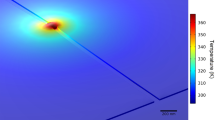Abstract
The atomic force microscopy (AFM)-based nanomachining of nanochannels on silicon oxide surfaces is investigated both theoretically and experimentally. The relationships of nanochannel depth versus cutting velocity, nanochannel depth versus normal force, friction force versus cutting velocity, and friction force versus normal force are systematically studied. Using the derived theory and fabrication method, a nanochannel with an expected depth can be machined simply by controlling the vertical deflection signal on the position sensitive detector of AFM. The theoretical analysis and fabrication method can be effectively used for AFM-based fabrication of nanochannels.
Similar content being viewed by others
References
Pelton R. Bioactive paper provides a low-cost platform for diagnostics. TrAC Trends Anal Chem, 2009, 28: 925–942
Day P J R. Miniaturized PCR systems for cancer diagnosis. Biochem Soc Trans, 2009, 37: 424–426
Assadollahi S, Reininger C, Palkovits R, et al. From lateral flow devices to a novel nano-color microfluidic assay. Sensors, 2009, 9: 6084–6100
Dharmasiri U, Balamurugan S, Adams A A, et al. Highly efficient capture and enumeration of low abundance prostate cancer cells using prostate-specific membrane antigen aptamers immobilized to a polymeric microfluidic device. Electrophoresis, 2009, 30: 3289–3300
Reichmuth D S, Wang S K, Barrett L M, et al. Rapid microchip-based electrophoretic immunoassays for the detection of swine influenza virus. Lab Chip, 2008, 8: 1319–1324
Brouzes E, Medkova M, Savenelli N, et al. Droplet microfluidic technology for single-cell high-throughput screening. Proc Natl Acad Sci USA, 2009, 106: 14195–14200
Zhao L, Cheng P, Li J X, et al. Analysis of nonadherent apoptotic cells by a quantum dots probe in a microfluidic device for drug screening. Anal Chem, 2009, 81: 7075–7080
Fakhoury J R, Sisson J C, Zhang X J. Microsystems for controlled genetic perturbation of live Drosophila embryos: RNA interference, development robustness and drug screening. Microfluid Nanofluid, 2009, 6: 299–313
Hong J, Edel J B, de Mello A J. Micro- and nanofluidic systems for high-throughput biological screening. Drug Disc Today, 2009, 14: 134–146
Li H F, Lin J M. Applications of microfluidic systems in environmental analysis. Anal Bioanal Chem, 2009, 393: 555–567
Palchetti I, Mascini M. Nucleic acid biosensors for environmental pollution monitoring. Analyst, 2008, 133: 846–854
Miro M, Hansen E H. Miniaturization of environmental chemical assays in flowing systems: The lab-on-a-valve approach vis-a-vis lab-on-a-chip microfluidic devices. Anal Chim Acta, 2007, 600: 46–57
Perry J L, Kandlikar S G. Review of fabrication of nanochannels for single phase liquid flow. Microfluid Nanofluid, 2006, 2: 185–193
Datta A, Gangopadhyay S, Temkin H, et al. Nanofludic channels by anodic bonding of amorphous silicon to glass to study ion-accumulation and ion-depletion effect. Talanta, 2006, 68: 659–665
Stern M B, Geis M W, Curtin J E. Nanochannel fabrication for chemical sensors. J Vac Sci Technol B, 1997, 15: 2887–2891
Cao H, Yu Z N, Wang J, et al. Fabrication of 10 nm enclosed nanofluidic channels. Appl Phys Lett, 2002, 81: 174–176
Wu H, Li M, Sun M X. Atomic force microscopic view of the fine topography on the tobacco stigma surface during its response to pollination. Chinese Sci Bull, 2008, 53: 1015–1020
He X X, Jin R, Yang L, et al. Study on the specific interaction between angiogenin and aptamer by atomic force microscopy (AFM). Chinese Sci Bull, 2008, 53: 198–203
Cross S E, Jin Y S, Rao J Y, et al. Nanomechanical analysis of cells from cancer patients. Nat Nanotech, 2007, 2: 780–783
Touhami A, Nysten B, Dufrene Y F. Nanoscale mapping of the elasiticty of microbial cells by atomic force microscopy. Langmuir, 2003, 19: 4539–4543
Nowakowski R, Luckham P, Winlove P. Imaging erythrocytes under physiological conditions by atomic force microscopy. BBA-Biomembranes, 2001, 1514: 170–176
Tian X J, Wang Y C, Xi N, et al. Pulse gas alignment and AFM manipulation of single-wall carbon nanotube. Chinese Sci Bull, 2008, 53: 3590–3596
Tian X J, Wang Y C, Yu H B, et al. Di-electrophoresis assembly and fabrication of SWCNT field-effect transistor. Chinese Sci Bull, 2009, 54: 4451–4457
Korayem M H, Zakeri M. Sensitivity analysis of nanoparticles pushing critical conditions in 2-D controlled nanomanipulation based on AFM. Int J Adv Manuf Tech, 2009, 41: 714–726
Mokaberi B, Yun J C, Wang M, et al. Automated nanomanipulation with atomic force microscopes. In: Proceedings of the 2007 IEEE International Conference on Robotics and Automation, Rome, 2007, 1406–1412
Chen H, Xi N, Li G Y. CAD-guided automated nanoassembly using atomic force microscopy-based nonorobotics. IEEE T Autom Sci Eng, 2006, 3: 208–217
Zhang Y J, Li P, Hu Y Z, et al. Manipulation and cutting of carbon nanotubes. Chinese Sci Bull, 2002, 47: 1696–1700
Bhushan B, Nanotribology and Nanomechanics. Berlin: Springer-Verlag, 2008
Bowden F P, Tabor D. The Friction and Lubrication of Solids. Oxford: Oxford University Press, 1950
Li G Y, Xi N, Yu M M, et al. Development of augmented reality system for AFM-based nanomanipulation. IEEE-ASME T Mech, 2004, 9: 358–365
Author information
Authors and Affiliations
Corresponding author
About this article
Cite this article
Wang, Z., Jiao, N., Tung, S. et al. Research on the atomic force microscopy-based fabrication of nanochannels on silicon oxide surfaces. Chin. Sci. Bull. 55, 3466–3471 (2010). https://doi.org/10.1007/s11434-010-4077-4
Received:
Accepted:
Published:
Issue Date:
DOI: https://doi.org/10.1007/s11434-010-4077-4




